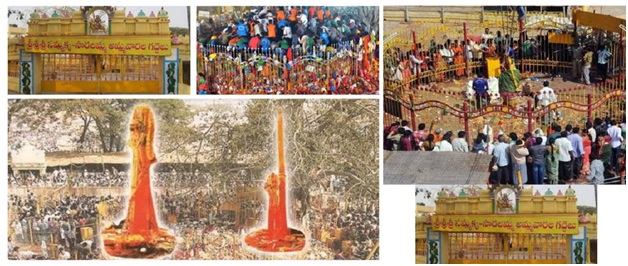The figures of Sammakka-Sarakka, their significance (Indian Express)

- 06 Oct 2023
Why is it in the News?
The Union cabinet has given its approval for the establishment of the Sarakka Central Tribal University in Telangana. This university will be located in the Mulugu district, with a budget of Rs 889 crore allocated for its development. During a recent visit to Telangana, the Prime Minister of India announced that the university would be named after Sammakka-Sarakka, a respected mother-daughter duo within the local tribal community.
News regarding the Sarakka Central Tribal University:
- The Central government had committed to establishing the Tribal University as part of the Andhra Pradesh Reorganisation Act, 2014.
- This Act resulted from the division of the former state of Andhra Pradesh into Telangana and the remaining Andhra Pradesh state, following the Telangana movement.
- According to the Act, both Andhra Pradesh and Telangana were entitled to support for the creation of a tribal university each.
- However, the Telangana tribal university faced significant challenges, primarily related to the timely allocation of 500-600 acres of land.
About the Legend of Sammakka and Sarakka:
- The Legend of Sammakka and Sarakka tells the story of Sammakka, who was married to Pagididda Raju, a feudal chief of the Kakatiyas, a Deccan dynasty that ruled the Warangal area.
- They had two daughters, Sarakka (also known as Saralamma) and Nagulamma, as well as a son named Jampanna.
- In the 13th century, a battle against local rulers erupted due to the imposition of taxes.
- Tragically, Saralamma lost her life in the conflict, while Sammakka disappeared into the hills.
- The local Koya tribals held a belief that Sammakka transformed into a vermillion casket.
The Sammakka Saralamma Jatara:
- Mulugu hosts a biennial festival known as the Sammakka Saralamma Jatara, often referred to as the tribal version of the Kumbh Mela.
- This event commemorates the courageous stand of the mother-daughter duo against the taxation imposed on the Koya people.
- Over time, this festival has grown significantly in importance, and it is believed that after the Kumbh Mela, the Sammakka Saralamma Jatara attracts the largest number of devotees in the country.
- Approximately 1.5 crore devotees, hailing from various tribal and non-tribal communities, participate in this festival, including people from Andhra Pradesh, Madhya Pradesh, Chhattisgarh, Odisha, and other regions.
- Due to the immense turnout, the Samakka-Sarakka Jatara was designated as a state festival in 1996.
The Political and Cultural Significance of the Sammakka Saralamma Jatara:
- This festival receives consistent participation from both the Union Ministry of Tribal Affairs and the Telangana state government, including the Chief Minister.
- The Central Government allocated Rs 6.25 crore for the yatras held in 2018, 2020, and 2022, with additional funds set aside for the construction of community shelters and other essential infrastructure.
- Furthermore, the Ministry of Tourism approved a substantial sum of Rs. 75.88 crore for the comprehensive development of a tribal circuit under the Swadesh Darshan Scheme.
- This tribal circuit encompasses Mulugu, Laknavaram, Medavaram, Tadvai, Damaravi, Mallur, and Bogatha Waterfalls, where the Sammakka-Sarakka temple is situated.
- Mulugu, an assembly seat reserved for Scheduled Tribes (ST), boasts a population of approximately 2.6 lakhs as per the 2011 Census, with a 75% ST population.
- Notably, the UNESCO World Heritage Site of Ramappa Temple is located just around 15 km from Mulugu.
